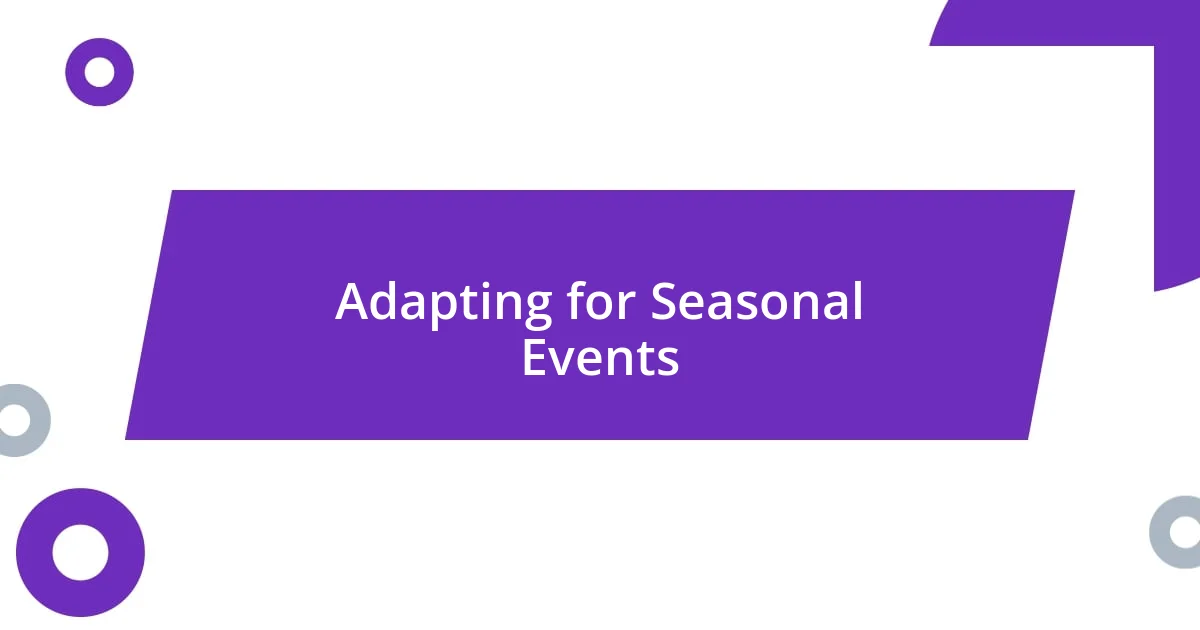Key takeaways:
- Understanding and utilizing seasonal floral trends enhances the emotional connection and authenticity of floral designs.
- Creating a seasonal floral calendar aids in planning arrangements, aligning flower availability with specific events and emotions.
- Engaging in community collaborations and interactive workshops promotes floral projects, while adapting designs for seasonal events enhances their impact and resonance.

Understanding Seasonal Floral Trends
Understanding seasonal floral trends is essential for any floral designer. I remember crafting a spring arrangement that burst with energy from bright tulips and cheerful daffodils. The way those flowers mirrored the awakening world outside made every bouquet a celebration of life itself. Isn’t it fascinating how certain blooms resonate with specific seasons, speaking to our hearts and uplifting our spirits?
As winter approaches, I often find myself drawn to the rich textures of amaryllis and the delicate beauty of evergreen boughs. These flowers offer a warmth that perfectly captures the essence of the season, evoking a sense of comfort. Have you noticed how the colors transform from the vibrant hues of summer to the muted tones of fall and winter? This shift always sparks my creativity, pushing me to think differently about arrangements.
Moreover, understanding these trends isn’t solely about aesthetics; it’s about connecting with your audience. When I rely on seasonal flowers, I can’t help but feel a sense of authenticity and relevance. Don’t you feel that way when you receive a bouquet that truly reflects the season? It’s these connections that make floral projects not just beautiful but meaningful.

Researching Seasonal Flower Availability
Researching seasonal flower availability is one of my favorite parts of planning floral projects. I often explore local florist websites and social media pages to see what blooms are currently thriving. For me, it’s like a treasure hunt; discovering a rare flower in mid-spring can ignite my enthusiasm, while it also compels me to think about how I can incorporate it into upcoming designs.
When I first started in floral design, tracking flower seasons felt overwhelming. I created a spreadsheet listing each flower’s peak season, which transformed my workflow significantly. This simple act not only kept my flower choices organized but also helped me anticipate trends and even plan ahead for special events. With that spreadsheet, I could dive into rings of seasonal hues, intertwining my projects with the rhythm of nature.
Regularly consulting resources like the American Society of Florists or local growing reports is another strategy I’ve adopted. It helps me stay informed, ensuring that I’m using flowers at their best. I often find myself excited to see how the availability of blooms evolves throughout the year, and it pushes me to explore new floral combinations. It’s incredible how a little research can lead to fresh inspiration and innovative arrangements!
| Season | Flower Options |
|---|---|
| Spring | Tulips, Daffodils, Peonies |
| Summer | Roses, Sunflowers, Zinnias |
| Fall | Chrysanthemums, Dahlias, Asters |
| Winter | Amaryllis, Pine, Poinsettias |

Creating a Seasonal Floral Calendar
Creating a seasonal floral calendar is not just practical; it’s a source of creative joy for me. I recall marking the first day of spring on my calendar and dreaming about the vibrant combinations I could conjure using fresh blossoms. By laying out a calendar, I can anticipate not only the florals available but also the emotions I want to evoke in each arrangement. There’s something genuinely uplifting about planning projects around the seasons; it feels like I’m dancing in rhythm with nature.
When I construct my seasonal floral calendar, I focus on a few essential points:
- Identify Peak Seasons: Each floral variety has its prime blooming times. Knowing these helps prevent disappointment.
- Local Availability: I always consider what’s locally sourced, as this often enhances the beauty and sustainability of my designs.
- Special Events: I plan ahead for holidays and celebrations. A wedding in June, for instance, might feature peonies and roses, while a fall harvest event could highlight rich dahlias and chrysanthemums.
- Trends & Themes: Keeping an eye on current inspirations and color palettes helps me align my designs with what’s trending.
- Personal Touch: I love including a few flowers that hold personal significance, be it from childhood gardens or memorable trips, to make each project feel uniquely mine.
By capturing these elements in my floral calendar, I feel more connected to my work and the seasons themselves, allowing my creativity to blossom.

Designing Seasonal Floral Arrangements
Designing seasonal floral arrangements is a delightful exercise in creativity that can make a significant difference in the overall aesthetics of any project. I often find myself reflecting on how different flowers set the mood for the season. For instance, when it’s time for a summer gathering, the warmth of sunflowers creates such a friendly atmosphere, don’t you think? This kind of emotional resonance drives my choices.
One of my favorite design techniques involves layering textures and colors that mirror the season’s essence. I vividly remember a fall wedding where I combined deep burgundy dahlias with golden mums and rustic elements like pinecones. That arrangement not only captured the season but also evoked a sense of coziness and warmth. It’s amazing how combining specific flowers can tell a story, transforming simple moments into cherished memories.
As the seasons shift, I embrace the beauty of experimentation. I often challenge myself to incorporate unexpected elements, like seasonal foliage or even herbs, into my designs. For example, using fresh rosemary in winter arrangements not only adds texture but also infuses a delightful fragrance. It encourages conversations, as guests often ask about the unique scents or unusual blooms. Does this ring a bell for you? Engaging the senses is a powerful way to deepen the experience of seasonal floral design.

Maintaining Seasonal Floral Supplies
Maintaining seasonal floral supplies can feel like a delicate balancing act, but I find it to be a rewarding part of my workflow. Every fall, I make it a point to visit local growers and establish relationships that allow me to understand their peak harvesting times. I remember one autumn, discovering a hidden gem of a nursery that offered an abundance of vibrant pomegranates for my arrangements. That connection not only ensured I had fresh supplies but also inspired me creatively while supporting local agriculture. Isn’t it wonderful to know that your work can directly benefit your community?
Storage plays a critical role in keeping my seasonal supplies fresh and vibrant. I’ve learned the hard way that proper care involves more than just keeping flowers in water. During a hot summer, I once stored delicate blooms too close to heat sources, only to see them wilt before my eyes. Since then, I’ve adopted a meticulous regimen of ensuring flowers are kept in a cool, dark place and hydrated properly. I often think of flowers as cherished companions; treating them with care and respect ensures they shine their brightest for my arrangements.
As I maintain my supplies, I also make room for seasonal variety and experimentation. I often challenge myself to source something unexpected each season, like when I stumbled upon heirloom pumpkins during a trip to the farmer’s market last Halloween. Integrating these stunning elements into my work has led to eye-catching, conversation-starting pieces that clients love. How often have you ventured outside your usual selections to create something new? I believe that these little adventures keep my floral projects fresh and allow my creativity to flourish.

Promoting Seasonal Floral Projects
Promoting seasonal floral projects is all about finding the right channels to share the beauty of what we create. I remember a time when I launched a spring collection with a vibrant social media campaign, showcasing the burst of colors in my arrangements. The excitement from followers was palpable, and it reminded me how important it is to not just share visuals, but to tell the story behind each seasonal project. Have you ever thought about how storytelling might enhance your own marketing efforts?
I’ve also discovered that hosting workshops has been a fantastic way to promote seasonal projects. During a winter event, I had attendees create their own centerpieces using aromatic evergreens and bright red berries. Seeing participants’ joy and their personal touches on each arrangement brought a wave of warmth. It struck me how making our work interactive can foster deeper connections with our floral art. Isn’t it rewarding to witness others engage with your craft in such a meaningful way?
Another effective strategy is collaborating with local businesses. A few years ago, I teamed up with a nearby café to curate seasonal displays that matched their menu specials. The synergy not only attracted foot traffic but also provided fresh inspiration for my arrangements. Each collaboration became a delightful opportunity to explore new themes while promoting my floral projects in a dynamic setting. Have you considered how partnerships could expand your reach and creativity?

Adapting for Seasonal Events
Adapting my floral projects for seasonal events means tuning into the moods and symbols of each season. For example, during a summer wedding I once styled, I incorporated sunflowers for their cheerful disposition, creating an atmosphere that radiated joy. Have you ever noticed how the right blooms can transform the vibe of an occasion? It always amazes me how thoughtful selections not only reflect the season but also enhance the emotions tied to the event.
When I plan for seasonal holidays like Thanksgiving, I consciously lean into traditional themes but with a twist. One year, I focused on deep burgundy and rich gold hues, wrapping my arrangements with scented cinnamon sticks for added texture and aroma. This blend of visual and sensory elements created a captivating experience. How do you evoke the senses in your own floral designs? I find that introducing unique elements, like fragrances or unexpected textures, brings a layer of depth that guests appreciate.
As I prepare for events like Valentine’s Day, I’ve learned the importance of customizing designs to suit the audience. I remember crafting a heart-shaped wreath using red roses and delicate baby’s breath for a romantic touch. It was rewarding to see the delighted reactions from couples as they picked up their orders. Connecting your designs with emotions can truly elevate your work. What strategies do you use to make your arrangements resonate emotionally with clients?














